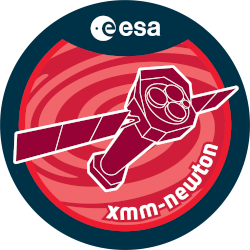

| Proposal ID | 076195 |
| Title | Probing Accretion and Obscuration in Luminous Red Quasars |
| Download Data Associated to the proposal | https://nxsa.esac.esa.int/nxsa-sl/servlet/data-action-aio?obsno=0761950101 |
| DOI | https://doi.org/10.5270/esa-bwqumqz |
| Principal Investigator, PI | Prof Eilat Glikman |
| Abstract | We propose to obtain XMM observations of three highly luminous dust-reddenedquasars that appear to be young, transitional objects predicted by merger-drivenmodels of quasar/galaxy co-evolution. These sources have been well-studied inoptical through mid-infrared and have Eddington ratios >30%. Their black holemasses are relatively small compared to their host galaxies placing them belowthe MBH -- Lbulge relation. We propose to exploit the large collecting area ofthe EPIC cameras to measure NH and constrain the dust-to-gas ratios as well asthe photon index as an independent probe of Eddington ratio. We will alsomeasure their X-ray luminosities to compare with the infrared. Theseobservations will complete the multi-wavelength study of this key population of quasars. |
| Publications |
|
| Instrument | EMOS1, EMOS2, EPN, OM, RGS1, RGS2 |
| Temporal Coverage | 2015-05-21T04:24:36Z/2016-03-18T02:53:32Z |
| Version | 17.56_20190403_1200 |
| Mission Description | The European Space Agencys (ESA) X-ray Multi-Mirror Mission (XMM-Newton) was launched by an Ariane 504 on December 10th 1999. XMM-Newton is ESAs second cornerstone of the Horizon 2000 Science Programme. It carries 3 high throughput X-ray telescopes with an unprecedented effective area, and an optical monitor, the first flown on a X-ray observatory. The large collecting area and ability to make long uninterrupted exposures provide highly sensitive observations. Since Earths atmosphere blocks out all X-rays, only a telescope in space can detect and study celestial X-ray sources. The XMM-Newton mission is helping scientists to solve a number of cosmic mysteries, ranging from the enigmatic black holes to the origins of the Universe itself. Observing time on XMM-Newton is being made available to the scientific community, applying for observational periods on a competitive basis. |
| Creator Contact | https://www.cosmos.esa.int/web/xmm-newton/xmm-newton-helpdesk |
| Date Published | 2017-04-08T22:00:00Z |
| Last Update | 2025-08-04 |
| Keywords | "galaxy co evolution", "luminous red quasars", "gas ratios", "eddington ratios", "transitional objects predicted", "merger driven models", "XMM", "key population", "multi wavelength", "galaxy placing", "photon index", "xray luminosities", "mid infrared", "mbh lbulge relation", "eddington ratio", "blackhole masses", "probing accretion", "epic cameras", "EPIC" |
| Publisher And Registrant | European Space Agency |
| Credit Guidelines | European Space Agency, Prof Eilat Glikman, 2017, 'Probing Accretion and Obscuration in Luminous Red Quasars', 17.56_20190403_1200, European Space Agency, https://doi.org/10.5270/esa-bwqumqz |